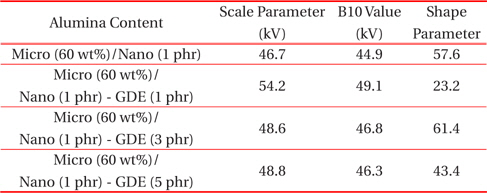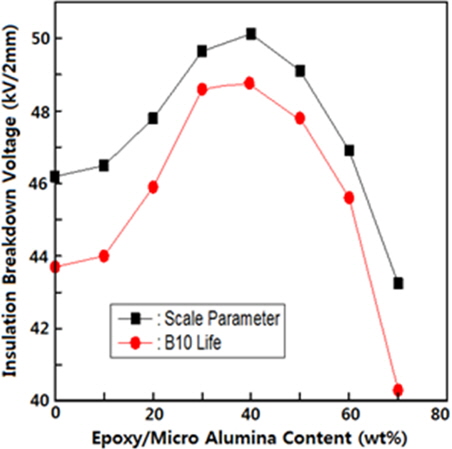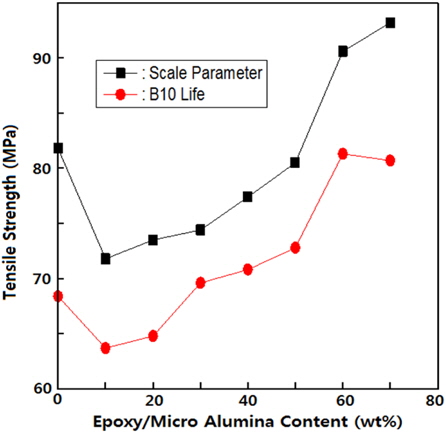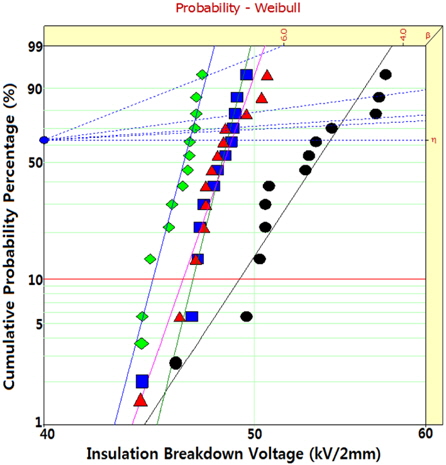



Epoxy resins are well-known materials in the field of insulation systems for heavy electric equipment, such as mold-type transformers, current transformers (CT), potential transformers (PT), metering out-fit (MOF), and gas insulated switchgears (GIS) [1-3], because they have good mechanical and thermal properties as well as excellent electrical properties. In the last two decades, the rapid development of epoxy-based composites in electric applications has been achieved to give the epoxy resins much higher electrical performance with lower cost. Usually, they have been used by loading micro-sized inorganic particles, typically around 65~80 wt% in order to achieve the same low level thermal expansion as the copper of an aluminum conductor that avoids the exfoliating between the epoxy casting part and the conductor. This is because many electric apparatus are operated under various heat-cycle of outside environmental temperature [4].
Switchgears are used to control, protect and isolate electrical equipment by combining electrically disconnected switches, fuses or circuit breakers. By the early 20th century, a switchgearlineup would be a metal-enclosed structure with electrically operated switching elements, using oil circuit breakers. Today, oilfilled equipment has largely been replaced by air-blast, vacuum, or SF6 equipment, allowing large currents and power levels to be safely controlled by automatic equipment. SF6 is an alternative to other conventional insulating and quenching media, such as oil and air. The use of SF6 gas considerably increases, in some applications, the efficient utilization of resources in energy transmission and distribution with respect to technology, finances and personnel [5,6]. An overall evaluation considering all ecological, economic, safety and technological aspects has proven that SF6 is still an excellent choice as an insulating medium [7,8]. The existing SF6 technology in the field of energy transmission and distribution is the result of decades of optimization and essentially contributes to the further development of economically efficient power distribution.
In general, pure SF6 is chemically inert: it cannot, therefore, cause corrosion. However, in the presence of moisture, however, the primary and secondary decomposition products of sulphur hexafluorideform corrosive electrolytes may cause damage and operational failure, particularly in electrical equipment. Therefore, silica particles and a silane coupling agent were corroded. As a result, alumina was used in the SF6 type switchgear materials.
In this study, epoxy/micro-sized alumina composite was prepared, and then an electrical insulation breakdown test and tensile test were carried out and the data were estimated by Weibull statistical analysis [9]. Nano-sized alumina was also incorporated into the epoxy/micro-sized alumina composite and its electrical and mechanical properties were studied.
A commercial solid, unmodified bisphenol A type based epoxy resin was used whose trade name was AralditeB46 (Huntsman International LLC.). Its epoxy equivalent weight was 2.30~2.45 eq./kg and the viscosity was 650~850 mPa·s at 120℃. Its melting range was 35~50℃. A carboxylic acid anhydride based curing agent was used whose grade name was HT 901 (Huntsman International LLC.). Its melting range was 128~132℃ and the acid content was ≤3. In addition, the accelerator was benzyl-dimethyl amine (BDMA) purchased from Kukdo Chem. Co. Its viscosity was ≤ 300 mPa·s at 120℃. Micro-sized alumina with an average particle size of 5.0 μm was purchased from Sibelco Korea. Its product name was SA-0109. Nano-sized alumina with an average particle size of 30 nm was purchased from Sukgyung AT Co., Korea. Its product name was SG-ALO30. In order to modify the surface characteristics of nano-sized alumina, glycerol diglycidyl ether (GDE) was used. GDE was purchased from Sigma - Aldrich Co.
In the first step, solid type epoxy base resin (30 g) was solved in toluene (100 g) at 80℃ and GDE (0.3, 0.9 or 1.5 g, respectively) was also solved in the toluene. Subsequently, nano-sized alumina (3 g) was poured into the toluene and the mixture was mixed using the homogenizer at 10,000 rpm for 3 hr together with a 500W probe-type ultrasonic processor (VC 505, Sonics & Materials Inc.) at a frequency of 20 kHz in order to disperse the nanosized alumina into the epoxy resin. Then toluene was removed from the epoxy/nano-sized alumina composite using a vacuum oven at 80℃ for 24 hr. The dried epoxy/nano-sized alumina was stored in a desiccator.
In the second step, the epoxy base resin (90 g) was melted at 140℃ in another beaker, and the epoxy/nano-sized alumina mixture (11 g) and micro-sized alumina (0, 14.7, 33, 56.6, 88, 132, 198 or 308 g) were poured into the beaker and mixed well for 4 hr using a mechanical agitator with 600 rpm, and it was degassed at vacuum condition (0.1 MPa) for 1 hr under the same temperature and agitating condition. And then, curing agent (30 g) and BDMA (1 g) were poured into the beaker and mixed well for 30 min under the same vacuum, temperature and agitating conditions. In the final mixture, the micro-sized alumina contents were to be 0, 10, 20, 30, 40, 50, 60 or 70 wt% and nano-sized alumina content was to be 1 phr, where phr meant part per one hundred epoxy base resin.
The mixture was poured into specimen molds, which were preheated at 140℃ in a vacuum oven. The mold for the insulation breakdown test was designed to be a 2 mm thickness with a 100 mm diameter and specimens for a tensile test were prepared under the recommendation of JIS B7502. The mixture in the mold was cured at 140℃ for 16 hr and it was cooled slowly at a rate of -0.5℃/min until room temperature in order to avoid internal stress, which would act as a disadvantage in the electrical insulation material.
2.3 AC insulation breakdown test
Sphere-to-sphere electrodes were arranged to an insulation thickness of 2 mm in order to measure the AC insulation breakdown strength. The electrodes were made of copper and their sphere diameters were 7.40 mm. Then, the specimen and electrodes were dipped into insulating oil that was 25℃ and high voltage (HV) was applied using an AC endurance voltage tester (Haefely, Germany) at a rising speed of 1 kV/s until the electrical insulation breakdown took place, where the AC frequency was 60 Hz. The specification of the HV generator was as follows: it was controlled at the frequency of 60 Hz with the maximum voltage of 400 kV. The secondary maximum current was 1,000 mA with a system of 400 kVA. The voltage, current and frequency data were automatically collected every five seconds, and all the data about the insulation breakdown strength were estimated by Weibull statistical analysis [9].
In order to study mechanical strength, a tensile test was carried out using a universal testing machine (SHM-C-500, Shamhan Tech, Korea). It was carried out under the recommendation of JIS B7502 at a crosshead speed of 10 mm/min at 23℃ and 50% relative humidity.
Figure 1 shows the Weibull statistical analysis (Weibull++7.0) for the insulation breakdown strength of epoxy/micro-sized alumina (60 wt%). The scale and shape parameters, and the B10 life can be obtained from the Weibull plot.
That is to say, the scale parameter represents the AC electrical breakdown strength by which 63.2% of the cumulative probability was expected to fail and the shape parameter can be obtained from the slope, which means the data distribution. In addition, the B10 value refers to the electrical breakdown strength at which 10% will fail (90% will survive) under a given test condition. Here, the scale parameter was 46.7 kV/2 mm and the B10 life was 44.9kV/2 mm, and the shape parameter was 57.6.
Figure 2 shows the effect of micro-sized alumina content on the insulation breakdown strength of the epoxy/micro-sized alumina composite. The sale parameter (■) and B10 life (●) was obtained from the Weibull statistical analysis. As the microsized alumina content increased, the scale parameter and B10 life of the insulation breakdown strength increased until 40 wt% alumina content and decreased after that content. The insulation breakdown strength for the neat epoxy system was 46.1 kV/2 mm and that for the 40 wt% alumina system was 50.1 kV/2 mm, which was a 108.7% higher value than that of the neat epoxy system. This meant that alumina particles had a good effect on the insulation breakdown strength of an epoxy system. However,alumina content that is too excessive disturbs the mobility of the epoxy functional groups so that the crosslink density of the epoxy/alumina system decreases.
Figure 3 shows the effect of micro-sized alumina content on the tensile strength of the epoxy/micro-sized alumina composite. The Weibull parameters were obtained from statistical analysis. The tensile strength for a neat epoxy system was 82.2 MPa and that value for 10 wt% alumina system was 72.6 MPa, which was 88.3% lower than that of the neat epoxy system. Furthemore, in the epoxy/micro-sized alumina systems, the tensile strength increased as the alumina content increased. When the micro-sized alumina content was low, the physical crosslink density was low and this value increased as the alumina content increased.
When the micro-sized alumina content was high, the tensile strength was higher than that of the neat epoxy system. The value at 60 wt% alumina content was 91.8 MPa, which was 111.7% higher than that of neat epoxy system.
Figure 4 shows the effect of the nano-sized alumina on the electrical breakdown strength of the epoxy/micro-sized alumina (60 wt%) composite. The effect of surface treating nano-sized alumina with GDE was also studied. The electrical breakdown strength was estimated by Weibull statistical analysis and the linear plots for (◆) micro-sized alumina (60 wt%), (●) micro-sized alumina (60 wt%)/nano-sized alumina (1 phr) - GDE (1 phr), (■) micro-sized alumina (60 wt%)/nano-sized alumina (1 phr) - GDE (3 phr) and (▲) micro-sized alumina (60 wt%)/nano-sized alumina (1 phr) - GDE (5 phr). Furthermore, the Weibull parameters were listed in Table 1. The statistical analysis showed that the scale parameter of micro-sized alumina (60 wt%) without nano-sized alumina was 46.7 MPa and the highest value was 54.2 MPa in the micro-sized alumina (60 wt%)/nano-sized alumina (1 phr) - GDE (1 phr) composite, which was about 116% higher than that of the system without nano-sized alumina. However, the value decreased as the GDE content increased. This meant that 1 phr of GDE had a good impact on the electrical breakdown strength, but excessive GDE was a harmful impurity.

Weibullparameters for an insulation breakdown voltage of epoxy/micro-sized alumina (60 wt%)/nano-sized alumina (1 phr) obtained from Fig. 4.
An epoxy/micro-sized alumina composite was prepared and the effects of alumina content on the electrical and mechanical properties were investigated in order to develop an insulation material for gas insulated switchgear (GIS). As micro-sized alumina content increased, the insulation breakdown strength increased until 40 wt% alumina content and decreased after that content. The insulation breakdown strength for 40 wt% alumina system was 50.1 kV/2 mm, which was 108.7% higher value than that of the neat epoxy system. Tensile strength for a neat epoxy system was 82.2 MPa and that value for 60 wt% alumina content was 91.8 MPa, which was 111.7% higher than that of a neat epoxy system. The scale parameter of micro-sized alumina (60 wt%) without a nano-sized alumina was 46.7 MPa and the highest value was 54.2 MPa in the micro-sized alumina (60 wt%)/nano-sized alumina (1 phr) - GDE (1 phr) composite, which was about. 116% higher than that of the system without nano-sized alumina.




